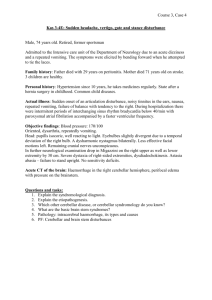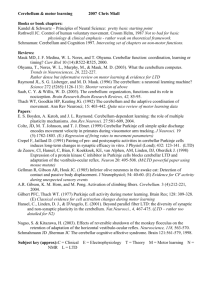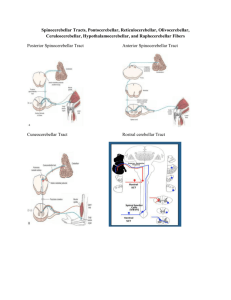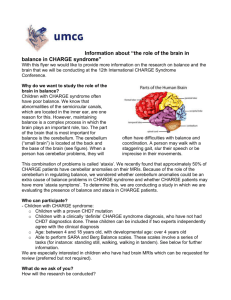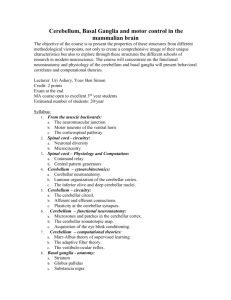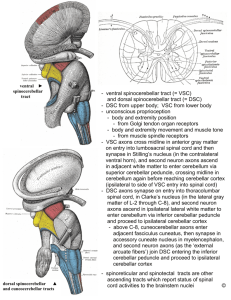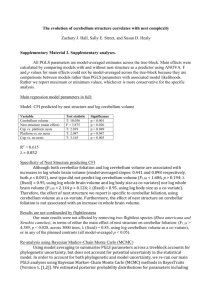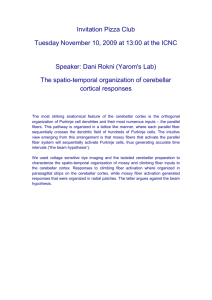Cross-linguistic Syntactic Priming Evidence for shared syntax
advertisement
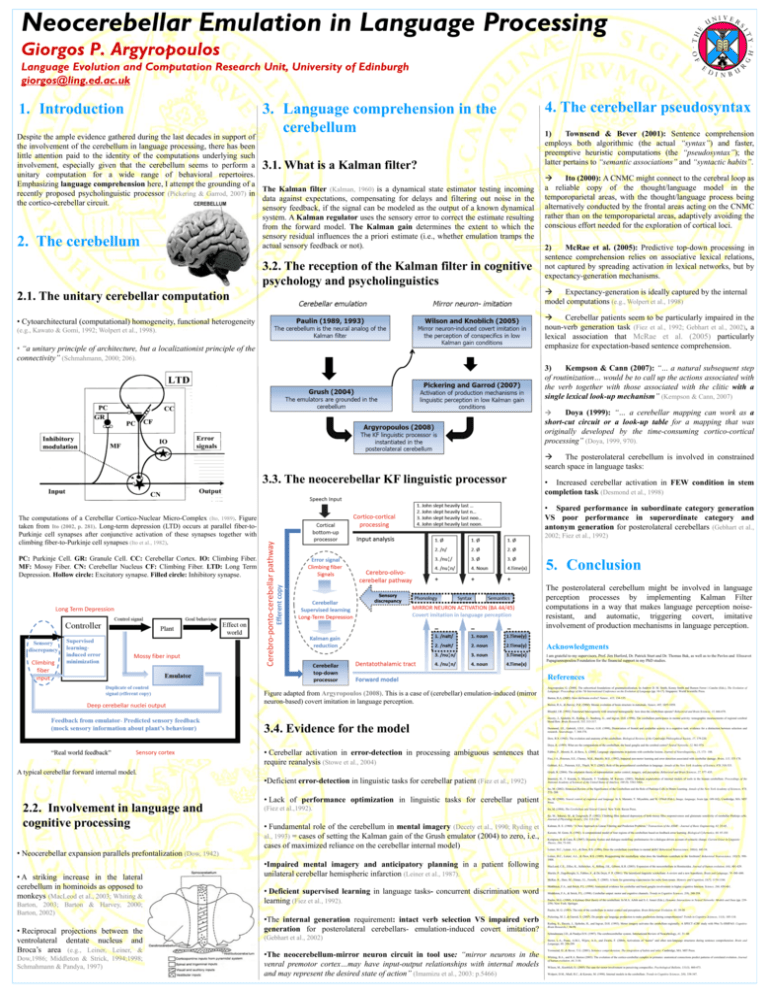
Neocerebellar Emulation in Language Processing Giorgos P. Argyropoulos Language Evolution and Computation Research Unit, University of Edinburgh giorgos@ling.ed.ac.uk 1. Introduction 3. Language comprehension in the cerebellum Despite the ample evidence gathered during the last decades in support of the involvement of the cerebellum in language processing, there has been little attention paid to the identity of the computations underlying such involvement, especially given that the cerebellum seems to perform a 3.1. What is a Kalman filter? unitary computation for a wide range of behavioral repertoires. Emphasizing language comprehension here, I attempt the grounding of a The Kalman filter (Kalman, 1960) is a dynamical state estimator testing incoming recently proposed psycholinguistic processor (Pickering & Garrod, 2007) in data against expectations, compensating for delays and filtering out noise in the the cortico-cerebellar circuit. sensory feedback, if the signal can be modeled as the output of a known dynamical system. A Kalman regulator uses the sensory error to correct the estimate resulting from the forward model. The Kalman gain determines the extent to which the sensory residual influences the a priori estimate (i.e., whether emulation tramps the actual sensory feedback or not). 2. The cerebellum 3.2. The reception of the Kalman filter in cognitive psychology and psycholinguistics 2.1. The unitary cerebellar computation 4. The cerebellar pseudosyntax 1) Townsend & Bever (2001): Sentence comprehension employs both algorithmic (the actual “syntax”) and faster, preemptive heuristic computations (the “pseudosyntax”); the latter pertains to “semantic associations” and “syntactic habits”. Ito (2000): A CNMC might connect to the cerebral loop as a reliable copy of the thought/language model in the temporoparietal areas, with the thought/language process being alternatively conducted by the frontal areas acting on the CNMC rather than on the temporoparietal areas, adaptively avoiding the conscious effort needed for the exploration of cortical loci. 2) McRae et al. (2005): Predictive top-down processing in sentence comprehension relies on associative lexical relations, not captured by spreading activation in lexical networks, but by expectancy-generation mechanisms. Expectancy-generation is ideally captured by the internal model computations (e.g., Wolpert et al., 1998) Cerebellar patients seem to be particularly impaired in the noun-verb generation task (Fiez et al., 1992; Gebhart et al., 2002), a lexical association that McRae et al. (2005) particularly emphasize for expectation-based sentence comprehension. • Cytoarchitectural (computational) homogeneity, functional heterogeneity (e.g., Kawato & Gomi, 1992; Wolpert et al., 1998). • “a unitary principle of architecture, but a localizationist principle of the connectivity” (Schmahmann, 2000; 206). 3) Kempson & Cann (2007): “… a natural subsequent step of routinization… would be to call up the actions associated with the verb together with those associated with the clitic with a single lexical look-up mechanism” (Kempson & Cann, 2007) Doya (1999): “… a cerebellar mapping can work as a short-cut circuit or a look-up table for a mapping that was originally developed by the time-consuming cortico-cortical processing” (Doya, 1999, 970). The posterolateral cerebellum is involved in constrained search space in language tasks: 3.3. The neocerebellar KF linguistic processor • Increased cerebellar activation in FEW condition in stem completion task (Desmond et al., 1998) • Spared performance in subordinate category generation VS poor performance in superordinate category and antonym generation for posterolateral cerebellars (Gebhart et al., The computations of a Cerebellar Cortico-Nuclear Micro-Complex (Ito, 1989). Figure taken from Ito (2002, p. 281). Long-term depression (LTD) occurs at parallel fiber-toPurkinje cell synapses after conjunctive activation of these synapses together with climbing fiber-to-Purkinje cell synapses (Ito et al., 1982). 2002; Fiez et al., 1992) PC: Purkinje Cell. GR: Granule Cell. CC: Cerebellar Cortex. IO: Climbing Fiber. MF: Mossy Fiber. CN: Cerebellar Nucleus CF: Climbing Fiber. LTD: Long Term Depression. Hollow circle: Excitatory synapse. Filled circle: Inhibitory synapse. 5. Conclusion The posterolateral cerebellum might be involved in language perception processes by implementing Kalman Filter computations in a way that makes language perception noiseresistant, and automatic, triggering covert, imitative involvement of production mechanisms in language perception. Acknowledgments I am grateful to my supervisors, Prof. Jim Hurford, Dr. Patrick Sturt and Dr. Thomas Bak, as well as to the Pavlos and Elissavet Papagiannopoulou Foundation for the financial support in my PhD studies. References Figure adapted from Argyropoulos (2008). This is a case of (cerebellar) emulation-induced (mirror neuron-based) covert imitation in language perception. Argyropoulos, G. (2008). The subcortical foundations of grammaticalization. In Andrew D. M. Smith, Kenny Smith and Ramon Ferrer i Cancho (Eds.), The Evolution of Language: Proceedings of the 7th International Conference on the Evolution of Language (pp. 10-17). Singapore: World Scientific Press. Barton, R.A. (2002). How did brains evolve? Nature , 415, 134-135. Barton, R.A., & Harvey, P.H. (2000). Mosaic evolution of brain structure in mammals. Nature, 405, 1055-1058. Bloedel, J.R. (1992). Functional heterogeneity with structural homogeneity: how does the cerebellum operate? Behavioral and Brain Sciences, 15, 666-678. Decety, J., Sjoholm, H., Ryding, E., Stenberg, G., and Ingvar, D.H. (1990), The cerebellum participates in mental activity: tomographic measurements of regional cerebral blood flow. Brain Research, 535, 313-317. 3.4. Evidence for the model Desmond, J.E., Gabrieli, J.D.E., Glover, G.H. (1998), Dissociation of frontal and cerebellar activity in a cognitive task: evidence for a distinction between selection and research. Neuroimage, 7, 368-376. Dow, R.S. (1942). The evolution and anatomy of the cerebellum. Biological Reviews of the Cambridge Philosophical Society, 17, 179-220. Doya, K. (1999). What are the computations of the cerebellum, the basal ganglia and the cerebral cortex? Neural Networks, 12, 961-974. • Cerebellar activation in error-detection in processing ambiguous sentences that require reanalysis (Stowe et al., 2004) A typical cerebellar forward internal model. Fabbro, F., Moretti, R., & Bava, A. (2000). Language impairments in patients with cerebellar lesions. Journal of Neurolinguistics, 13, 173– 188. Fiez, J.A., Petersen, S.E., Cheney, M.K., Raichle, M.E. (1992), Impaired non-motor learning and error detection associated with cerebellar damage. Brain, 115, 155-178. Gebhart, A.L., Petersen, S.E., Thach, W.T. (2002). Role of the posterolateral cerebellum in language. Annals of the New York Academy of Science, 978, 318-333. Grush, R. (2004). The emulation theory of representation: motor control, imagery, and perception. Behavioral and Brain Sciences, 27, 377–435. •Deficient error-detection in linguistic tasks for cerebellar patient (Fiez et al., 1992) Imamizu, H., T. Kuroda, S. Miyauchi, T. Yoshioka, M. Kawato. (2003), Modular organization of internal models of tools in the human cerebellum. Proceedings of the National Academy of Sciences of the United States of America, 100 (9), 5361-5466. Ito, M. (2002). Historical Review of the Significance of the Cerebellum and the Role of Purkinje Cells in Motor Learning. Annals of the New York Academy of Sciences, 978, 273- 288. 2.2. Involvement in language and cognitive processing • Neocerebellar expansion parallels prefontalization (Dow, 1942) • A striking increase in the lateral cerebellum in hominoids as opposed to monkeys (MacLeod et al., 2003; Whiting & Barton, 2003; Barton & Harvey, 2000; Barton, 2002) • Reciprocal projections between the ventrolateral dentate nucleus and Broca’s area (e.g., Leiner, Leiner, & Dow,1986; Middleton & Strick, 1994;1998; Schmahmann & Pandya, 1997) • Lack of performance optimization in linguistic tasks for cerebellar patient Ito, M. (2000). Neural control of cognition and language. In A. Marantz, Y. Miyashita, and W. O'Neil (Eds.), Image, language, brain (pp. 149-162). Cambridge, MA: MIT Press. (Fiez et al.,1992). Ito, M. (1984), The Cerebellum and Neural Control. New York: Raven Press. Ito, M., Sakurai, M., & Tongroach, P. (1982). Climbing fibre induced depression of both mossy fibre responsiveness and glutamate sensitivity of cerebellar Purkinje cells. Journal of Physiology (Lond.), 324, 113-134. • Fundamental role of the cerebellum in mental imagery (Decety et al., 1990; Ryding et al., 1993) = cases of setting the Kalman gain of the Grush emulator (2004) to zero, i.e., cases of maximized reliance on the cerebellar internal model) •Impaired mental imagery and anticipatory planning in a patient following unilateral cerebellar hemispheric infarction (Leiner et al., 1987). Kalman, R. E. (1960). "A New Approach to Linear Filtering and Prediction Problems," Transactions of the ASME - Journal of Basic Engineering, 82, 35-45. Kawato, M. Gomi, H. (1992). A computational model of four regions of the cerebellum based on feedback-error learning. Biological Cybernetics, 68, 95-103. Kempson, R. & Cann, R. (2007). Dynamic Syntax and dialogue modelling: preliminaries for a dialogue-driven account of syntactic change. Current Issues in Linguistic Theory, 284, 73-101. Leiner, H.C., Leiner, A.L., & Dow, R.S. (1986). Does the cerebellum contribute to mental skills? Behavioral Neuroscience, 100(4), 443-54. Leiner, H.C., Leiner, A.L., & Dow, R.S. (1989). Reappraising the cerebellum: what does the hindbrain contribute to the forebrain? Behavioral Neuroscience, 103(5), 9981008. MacLeod, C.E., Zilles, K., Schleicher, A., Rilling, J.K., Gibson, K.R. (2003). Expansion of the neocerebellum in Hominoidea. Journal of human evolution, (44), 401-429. Mariën, P., Engelborghs, S., Fabbro, F., & De Deyn, P. P. (2001). The lateralized linguistic cerebellum: A review and a new hypothesis. Brain and Language, 79, 580–600. McRae, K., Hare, M., Elman, J.L., Ferretti, T. (2005). A basis for generating expectancies for verbs from nouns. Memory and Cognition, 33(7), 1174-1184. • Deficient supervised learning in language tasks- concurrent discrimination word learning (Fiez et al., 1992). Middleton, F.A., and Strick, P.L. (1994). Anatomical evidence for cerebellar and basal ganglia involvement in higher cognitive function. Science, 266, 458-461. Middleton, F.A., & Strick, P.L. (1998). Cerebellar output: motor and cognitive channels. Trends in Cognitive Sciences, 2(9), 348-354. Paulin, M.G. (1989). A Kalman filter theory of the cerebellum. In M.A. Arbib and S.-I. Amari (Eds.), Dynamic Interactions in Neural Networks: Models and Data (pp. 239259). New York: Springer. Paulin, M. G. (1993). The role of the cerebellum in motor control and perception. Brain Behaviour Evolution. 41: 39-50 •The internal generation requirement: intact verb selection VS impaired verb generation for posterolateral cerebellars- emulation-induced covert imitation? (Gebhart et al., 2002) •The neocerebellum-mirror neuron circuit in tool use: “mirror neurons in the venral premotor cortex…may have input-output relationships with internal models and may represent the desired state of action” (Imamizu et al., 2003: p.5466) Pickering, M. J., & Garrod, S. (2007). Do people use language production to make predictions during comprehension? Trends in Cognitive Sciences, 11(3), 105-110. Ryding, E., Decety, J., Sjoholm, H., and Ingvar, D.H. (1993). Motor imagery activates the cerebellum regionally. A SPECT rCBF study with 99m Tc-HMPAO. Cognitive Brain Research,1, 94-99. Schmahmann J.D., & Pandya D.N. (1997). The cerebrocerebellar system. International Review of Neurobiology, 41, 31–60. Stowe, L.A., Paans, A.M.J., Wijers, A.A., and Zwarts, F. (2004), Activations of “motor” and other non-language structures during sentence comprehension. Brain and Language, 89, 290-299. Townsend, D., & Bever, T.G. (2001). Sentence comprehension: The integration of habits and rules. Cambridge, MA. MIT Press. Whiting, B.A., and R.A. Barton (2003). The evolution of the cortico-cerebellar complex in primates: anatomical connections predict patterns of correlated evolution. Journal of human evolution ,44, 3-10. Wilson, M., Knoblich, G. (2005) The case for motor involvement in perceiving conspecifics. Psychological Bulletin, 131(3), 460-473. Wolpert, D.M., Miall, R.C., & Kawato, M. (1998). Internal models in the cerebellum. Trends in Cognitive Sciences, 2(9), 338-347.
